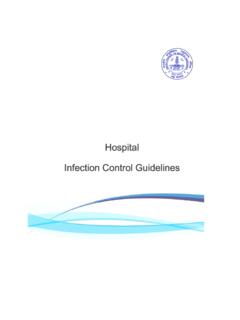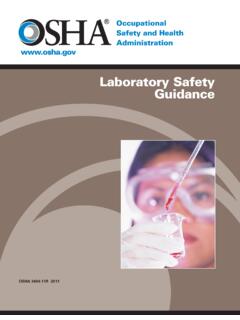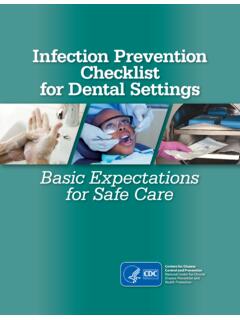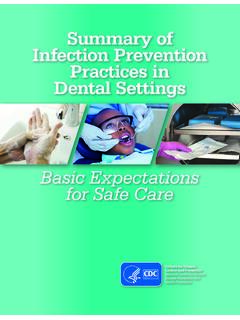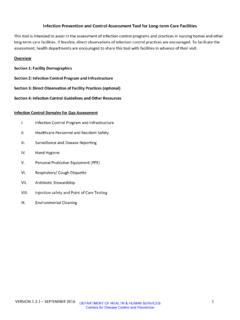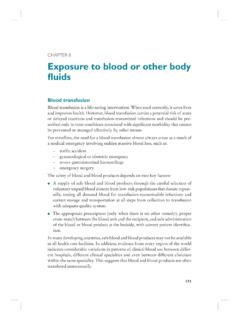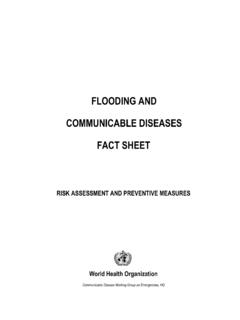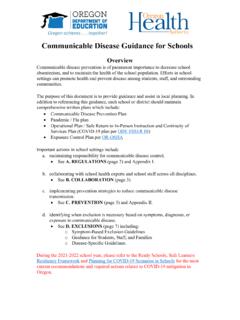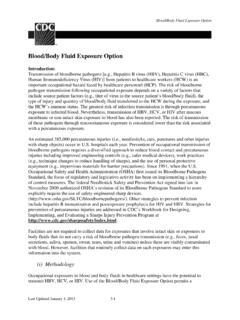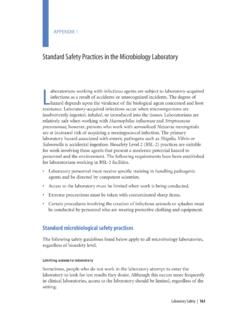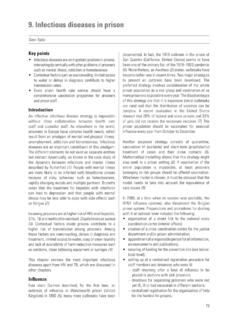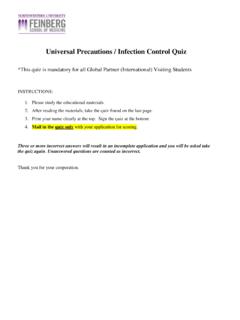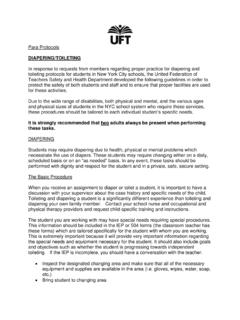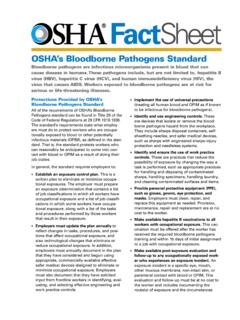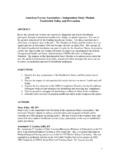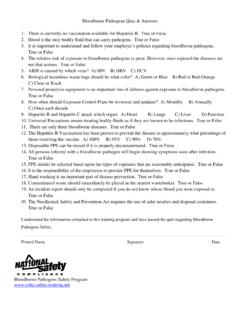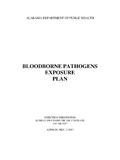Search results with tag "Bloodborne"
Occupational Exposure to Bloodborne Pathogens, Chapter …
lni.wa.govOccupational Exposure to Bloodborne Pathogens _____ Chapter 296-823 WAC Occupational Exposure to Bloodborne Pathogens (Form Number 414-073-000) This book contains rules for Safety Standards for occupational exposure to bloodborne pathogens, as adopted under the Washington Industrial Safety and Health Act of 1973 (Chapter 49.17 RCW).
Hospital Infection Control Guidelines
main.icmr.nic.inbloodborne infections such as HIV, hepatitis B, hepatitis C and other bloodborne pathogens while being provided health care. Components : Universal precautions consider only certain body fluids as capable of transmitting bloodborne diseases (Table 1). It advocates the use of barriers to prevent occupational exposure
Standard Precautions and Infection Control
peoplecarehs.comStandard Precautions for Bloodborne Transmission Bloodborne transmission means that a disease is spread when the blood of an infected person reaches the bloodstream of another person. Standard Precautions are what you should do to practice basic infection con-trol against bloodborne disease.
Preventing the Transmission of Bloodborne Pathogens - AAOS
aaos.orgInformation Statement . Preventing the Transmission of Bloodborne Pathogens . This Information Statement was developed as an educational tool based on the opinion of the authors.
Name: Class: Date: ID: A - Occupational Safety and Health ...
www.osha.govMedical follow up after exposure risk of blood or OPIM exposure 2. Epidemiology is: a. The medical science behind tracking and c. The signs and symptoms that will show if controlling bloodborne diseases the employee develops a BBP infection b. The bloodborne pathogen standard d. A layer of the skin 3.
Exposure Control Plan for Bloodborne Pathogens
www.dir.ca.govpational exposure to blood or other potentially infectious materials (OPIM) vary widely. Therefore, a basic bloodborne pathogens exposure control plan has been designed to provide streamlined implementation procedures. The plan promotes the use of safer engineering controls and more effec-
Laboratory Safety Guidance - Occupational Safety and ...
www.osha.govor other potentially infectious materials (OPIM). It requires that information and training be provided before the worker begins work that may involve occupational exposure to bloodborne pathogens, annually thereafter, and before a worker is offered hepatitis B vaccination. The Bloodborne Pathogens standard also requires advance information and ...
Protecting Yourself When Handling Contaminated Sharps
www.osha.govbloodborne pathogens. The standard specifies measures to reduce these types of injuries and the risk of infection. Careful handling of contaminated sharps can prevent injury and reduce the risk of infection. Employers must ensure that workers follow these work practices to decrease the workers’ chances of contracting bloodborne diseases.
Infectious disease control in the workplace
www.rpta.orgBloodborne diseases Bloodborne diseases such as Hepatitis B (HBV), Hepatitis C (HCV), Hepatitis D (HDV), and Human Immunodeficiency Virus (HIV) are acquired from close contact with an infected person's body fluids. Some examples include administering first aid, sharing needles, unprotected sexual contact, blood transfusions (rarely),
boschert htbna 7e
066b40b5535506586917-68298049b65edbd7ec9f493f0b1c8eb3.ssl.cf2.rackcdn.comperson can spread the infection to others. OSHA Bloodborne Pathogens Standard You learned about standard precautions that must be used to prevent the transmission of infection. The Occupational Safety and Health Administration (OSHA) Bloodborne Pathogens Standard requires all health-care agencies, including long term care facilities,
The National Healthcare Safety Network (NHSN) Manual
www.cdc.govTransmission of bloodborne pathogens [e.g., Hepatitis B virus (HBV), Hepatitis C virus (HBC), Human Immunodeficiency Virus (HIV)] from patients to healthcare workers (HCW) is an important occupational hazard faced by healthcare personnel (HCP). The risk of bloodborne
Infection Control/ Bloodborne Pathogens - Prophecy Health
nt.prophecyhealth.comInfection Control/Bloodborne Pathogens INTRODUCTION Infectious diseases are caused by microscopic organisms that penetrate the body’s natural barriers and multiply. They create symptoms that can range from mild to fatal. The U.S. Centers for Disease Control and Prevention (CDC), the World Health Organization, and other
Infection Prevention Checklist for Dental Settings
www.cdc.govA. Facility has an exposure control plan that is tailored to the specific requirements of the facility (e.g., addresses potential hazards posed by specific services provided by the facility) Note: A model template that includes a guide for creating an exposure control plan that meets the requirements of the OSHA Bloodborne Pathogens
Summary of Infection Prevention Practices in Dental Settings
www.cdc.govStandard Precautions and other infection prevention ... care but potentially exposed to infectious agents (e.g., administrative, clerical, housekeeping, maintenance, or volunteer personnel).5. 3 Objectives ... (OSHA) bloodborne pathogens standard to address patient safety. The infection prevention coordinator
Infection Prevention and Control Assessment Tool for …
www.cdc.govH. The facility has an exposure control plan which addresses potential hazards posed by specific services provided by the facility (e.g., blood-borne pathogens). Note: A model template, which includes a guide for creating an exposure control plan that meets the requirements of the OSHA Bloodborne Pathogens Standard is available at:
Exposure to blood or other body fl uids - WHO
www.who.intPost-exposure prophylaxis (PEP). PEP is an emergency medical response given as soon as possible to reduce the risk of transmission of bloodborne pathogens after potential exposure. It is available for HIV and hepatitis B. Accidental exposure to potentially infected blood or other body fl uids is a medical emergency.
FLOODING AND COMMUNICABLE DISEASES FACT SHEET
www.who.intWorld Health Organization Communicable Disease Working Group on Emergencies, HQ . ... • Exposure to bloodborne viruses occurs due to direct contact with non-intact skin of blood or body ... It is also highly effectiv e against nearly all waterborne pathogens (except Cryptosporidium parvum oocysts and Mycobacteria species). At doses of a few ...
Updated U.S. Public Health Service Guidelines for the ...
www.cdc.govthe person bitten and the person who inflicted the bite were exposed to bloodborne pathogens. Transmission of HBV or HIV infection only rarely has been reported by this route (18–20) (CDC, unpublished data, 1998). BACKGROUND This section provides the rationale for the postexposure management and prophy-laxis recommendations presented in this ...
BEST PRACTICES IN REPROCESSING REUSABLE MEDICAL …
www.njcl.us9/24/2015 5 CDC Mandates Dedicated IP Resources •Infection prevention programs -beyond OSHA bloodborne pathogen training •At least one individual trained in Infection Prevention • Policies and Procedures based on evidence-based guidelines • Tailored to the facility • Reassessed on a regular basis • Based on risk assessment • Focus extra attention on areas that pose greater risk
Communicable Disease Guidance for Schools
www.oregon.govJun 30, 2017 · exclusion of ill students and staff with specified communicable diseases and conditions (see . D. Exclusions, page 7). Develop, implement and review on an annual basis the Exposure Control Plan for Bloodborne Pathogens in the school setting per the OR-OSHA rule. Update when necessary to reflect occupational exposures related to new or
Texas Curriculum for Nurse Aides in Long-Term Care Facilities
www.hhs.texas.govBloodborne Pathogens - ... prevent the spread of infection by identifying potentially infectious individuals and using airborne, contact, and/or droplet precautions as indicated, in addition to standard precautions. 8 Revised: 1/2022 Procedural Guidelines Used in this Section
Integrated Guidance for Management of BBV in HCW - GOV.UK
assets.publishing.service.gov.ukIntegrated guidance on health clearance of healthcare workers and the management of healthcare workers living with bloodborne viruses (hepatitis B, hepatitis C and HIV) UK Advisory Panel for Healthcare Workers Living with …
Blood/Body Fluid Exposure Option
www.cdc.govJan 01, 2013 · equipment (e.g., impervious materials for barrier precautions). Since 1991, when the U.S. Occupational Safety and Health Administration (OSHA) first issued its Bloodborne Pathogens Standard, the focus of regulatory and legislative activity has been on implementing a hierarchy of control measures.
Guidelines for Human Biospecimen
oir.nih.govSafety and Health Administration’s Bloodborne Pathogens Standard. 10 Each laboratory collection or biorepository must have and adhere to a Standard Operating Procedure (SOP) for labeling, handling, and storage of biospecimens. Biospecimens containing select agents or toxins are regulated under 42 CFR 73 .
Standard Safety Practices in the Microbiology Laboratory
www.who.intassumed to be positive for hepatitis B virus, HIV, other bloodborne pathogens, and M. tuberculosis. These materials should be handled in a safety cabinet or using other barrier precautions (e.g.,goggles, mask, face shield, or other splatter guards) whenever a procedure is performed that can potentially create an aerosol.
9. Infectious diseases in prison - World Health Organization
www.euro.who.intdiseases are an important constituent of this amalgam. The different elements do not exist as separate entities but interact dynamically, as shown in the case study of the dynamics between infections and mental illness described by Rutherford (1). People with mental illness are more likely to be infected with bloodborne viruses
RESPIRATORY PROTECTION GUIDANCE
www.osha.gov(29 CFR 1910.132) and the Bloodborne Pathogens standard (29 CFR 1910.1030). When available, FDA-cleared or autho-rized surgical masks are preferred over cloth face coverings for healthcare workers, as they offer both source control and protection for the wearer against exposure to splashes and sprays of infectious material from others. They are
Universal Precautions/Infection Control Quiz
www.feinberg.northwestern.eduHealthcare workers involved in at-risk activities are required to complete bloodborne pathogen training within 10 days of employment, when job activities or responsibilities are changed, and annually. The training includes information about Standard Precautions, biohazardous waste handling, the post-exposure policy, and the Hepatitis vaccine.
DIAPERING/TOILETING
www.uft.orgOSHA Bloodborne Pathogen Training, which includes topics such as universal precautions, personal protective equipment and procedures to follow if you have a blood or body fluid exposure. You should also receive the hepatitis B Vaccine “free of charge.” 9 You may request training or seek advice from the school nurse, the
OSHA FACTSHEET BLOODBORNE PATHOGENS …
www.osha.govexposure, hepatitis B vaccine, and medical eval-uation and post-exposure follow-up procedures. Employers must offer this training on initial assignment, at least annually thereafter, and when new or modified tasks or procedures affect a worker’s occupational exposure. Also, HIV and HBV laboratory and production facility
Infection Prevention, Outbreaks, and the Role of Public Health
spice.unc.eduMay 04, 2018 · Pathogens Patient Safety (SHARPPS) Program Jennifer MacFarquhar Program Director James Lewis ... • Bloodborne pathogens Hepatitis B (HBV) Hepatitis C (HCV) Human Immunodeficiency Virus (HIV) ... higher risk for transmission 5. Hand Hygiene 6. …
Preventing and Managing Illnesses in Child Care Centres
www.peelregion.cabloodborne infections. • Wash your hands to prevent the spread of germs. For more information, please see the Cleaning Blood and Body Fluid Poster (Appendix 3).
Needlestick Safety and Prevention - World Health …
www.who.intEvery day, health care workers are exposed to dangerous and deadly bloodborne pathogens through contaminated needlesticks, sharps, or splash exposures. It is one of the greatest risks faced by the frontline health care worker. Yet, these exposures have often been considered “part of the job.” The Needlestick Safety and Prevention Act was
Screening Donated Blood for Transfusion- Transmissible ...
www.who.inttransmission, Infectious - prevention and control. 4.Donor selection. 5.National health programs. I.World Health Organization. ... and prevalence of bloodborne infections, the structure and level of development of the blood transfusion service, the resources available and special transfusion requirements. The safety of the blood supply also ...
Bloodborne Pathogens Exposure Control Plan
dsps.wi.govThe objective of this Bloodborne Pathogens Exposure Control Plan is to comply with the Occupational Safety and Health Administration’s Bloodborne Pathogens Standard, 29 CFR 1910.1030, and to eliminate or minimize employee occupational exposure to blood, certain other bodily fluids or other potentially infectious materials.
Bloodborne Pathogens Quiz & Answers - DiagnosTemps
diagnostemps.comBloodborne Pathogens Quiz & Answers 1. There is currently no vaccination available for Hepatitis B. True or False 2. Blood is the only bodily fluid that can carry pathogens. True or False 3. It is important to understand and follow your employer’s policies regarding bloodborne pathogens. True or False 4.
Bloodborne Pathogens - Occupational Safety and Health ...
www.osha.govBloodborne Pathogens Listed below are the names, titles and job responsibilities that may bring these individuals into contact with human blood or other potentially infectious materials, which may result in exposure to bloodborne pathogens: Name Title Job Responsibilities
BLOODBORNE PATHOGENS EXPOSURE PLAN
www.adph.orgBloodborne Pathogens Exposure Plan 3 February 2013 I. INTRODUCTION This Bloodborne Pathogens Exposure Control Plan was developed by the ADPH as a means to minimize employee exposure to human blood and other potentially infectious materials. It is designed to comply with the standards enunciated by the
Bloodborne Pathogens Promotional
lms.healthcareacademy.com2. List the 4 types of bloodborne pathogens. 3. List three (3) ways to prevent the spread of bloodborne pathogens. Author: Jocelyn Smith, MSN, RN Jocelyn has over 15 years’ experience in long term care, home health, and hospice. Her experience also includes case management and utilization management.
Bloodborne Pathogens Needlesticks Test Answer Key
www.osha.govBloodborne Pathogens and Needlestick Exposure . 1. Bloodborne Pathogens are … A. A-Dangerous germs that live everywhere B. B-Microorganisms that are present in human blood and can cause disease in humans C. C-Harmless germs D. D-Bacteria that live everywhere in the body that can cause severe sickness. 2. How can HIV, HBV, and HCV be spread? a.
Bloodborne Pathogens Exposure Control Plan
ehs.weill.cornell.eduCONTINUED: Bloodborne Pathogens Exposure Control Plan 7.0 Universal Precautions Universal Precautions is an approach to infection control that assumes that all human blood and other bodily fluids and tissues are potentially infectious materials (see definition of Other Potentially Infectious Materials). It is the policy of WCM that Universal
BLOODBORNE PATHOGENS Course Summary Handout
www.emsuniversity.comBLOODBORNE PATHOGENS Course Summary Handout HCV- Hepatitis C has the same signs and symptoms as HBV and also affects the liver, but there is no cure and treatments are more limited. HCV is much more common than HBV and HIV. There are medications to help treat the virus. 80% of …
BLOODBORNE PATHOGENS - Mesa Community College
www.mesacc.eduIf you work in an area with routine exposure to blood or potentially infectious materials, the necessary PPE should be readily accessible. Contaminated gloves, clothing, PPE, or other materials should be placed in appropriately labeled bags or containers until it is disposed of, decontaminated, or laundered. It
Similar queries
BLOODBORNE PATHOGENS, Hospital Infection Control Guidelines, Bloodborne, Bloodborne diseases, Spread, Preventing the Transmission of Bloodborne Pathogens, Name: Class: Date: ID: A, Exposure, Bloodborne Pathogen, Other Potentially, Laboratory Safety Guidance, Other potentially infectious materials, Bloodborne Pathogens Standard, Protecting Yourself When Handling Contaminated Sharps, Bloodborne diseases Bloodborne diseases, Transmission of bloodborne pathogens, Of bloodborne, Health, World Health Organization, Infection Prevention Checklist, Exposure control, Standard Precautions and other, Potentially, Infectious, Infection Prevention and Control Assessment Tool, Blood-borne, Exposure to blood or other, Pathogens, Transmission, BEST PRACTICES IN REPROCESSING REUSABLE MEDICAL, Communicable Disease Guidance, Diseases, Texas, Potentially infectious, Precautions, Standard precautions, Integrated, Integrated guidance on health clearance, Healthcare workers living with bloodborne viruses, Healthcare Workers Living with, Biospecimen, Standard, Other bloodborne pathogens, Materials, Other, 9. Infectious diseases in prison, RESPIRATORY PROTECTION GUIDANCE, Universal Precautions/Infection Control Quiz, Hepatitis, Preventing and Managing Illnesses in Child Care, The spread, Needlestick Safety and Prevention, World Health, Health care workers, Health care, Screening Donated Blood for Transfusion- Transmissible, Bloodborne Pathogens Quiz & Answers, Bloodborne Pathogens Exposure Plan, Bloodborne Pathogens Exposure, The spread of bloodborne, Bloodborne Pathogens Exposure Control Plan, And other, BLOODBORNE PATHOGENS Course Summary Handout, Mesa Community College, Area

